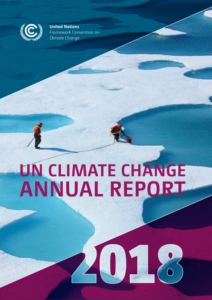The United Nations launched their UN Climate Change Annual report that reflects the key achievements of the UNFCCC process and the activities of the secretariat, particularly their impact in relation to the implementation of the Convention, the Kyoto Protocol and the Paris Agreement, while it also presents the outcomes of COP 24 and a look ahead.
The report opens with António Guterres, United Nations Secretary-General, commenting that
The UNFCCC Conference of Parties in Katowice was undoubtedly a step forward.
During the COP 24 in Katowice, Poland, parties from all around the world pushed further work on the fight against climate change, exactly three years after the Paris Agreement.
In light of the Paris Agreement, the sustainability goals and the urgency for a greener future, the report focuses on the importance of limiting and reducing the GHG emissions. Generally, the Paris Agreement aims to mitigate global warming below 2 °C and as close as possible to 1.5 °C. Yet, based on today’s trends, the World Meteorological Organization expects a global average temperature increase of 3–5 °C by 2100.
[smlsubform prepend=”GET THE SAFETY4SEA IN YOUR INBOX!” showname=false emailtxt=”” emailholder=”Enter your email address” showsubmit=true submittxt=”Submit” jsthanks=false thankyou=”Thank you for subscribing to our mailing list”]
Keeping in mind the dangers of a global warming, nations need to put the final touches to the Paris Agreement guidelines, including in relation to using market mechanisms to meet part of their domestic mitigation goals and back sustainable development. Pre2020 action is also crucial.
As Alexis Leroy, Founder and Chief Executive Officer, ALLCOT, reported
The Colombian legislation on carbon tax stimulates strategic transfer of technology … and delivers effective and accountable emission reductions for the country. It is not only of great economic benefit, but it is proven to be a solid contribution toward Colombia’s NDC.
Moreover, in order to achieve the needed sustainability goals, the Clean Development Mechanism (CDM), defined in Article 12 of the Protocol, allows a country with an emission-reduction or emission-limitation commitment under the Kyoto Protocol to implement an emission-reduction project in developing countries. Such projects can earn saleable certified emission reduction (CER) credits, each equivalent to one tonne of CO2, which can be counted towards meeting Kyoto targets.
Therefore, the report presented the outcomes of CDM:
- 140 countries involved, including 36 of the world’s least developed countries
- 152 million trees planted
- 25% of projects improve, protect and/or efficiently use natural resources
- 313 registered programmes of activities, with 2,156 component activities
- 840,000 people provided with clean drinking water
- 1 million efficient cookstoves installed, reducing emissions and improving health
- 200 million USD contributed to the Adaptation Fund
- 100,000 gigawatt hours of electricity generation per year from renewable sources, enough to supply Ecuador, Morocco, Myanmar and Peru together
In addition, the report further explained that the impacts of climate can cause loss and damage to human life, productive systems, property, infrastructure, wider socioeconomic systems and the natural environment. Some climate risks may not be addressed because they are not foreseen at the time of planning, or are foreseen but unaddressed owing to cultural, societal, geopolitical, economic and/ or technical constraints. Vulnerable countries need to be better equipped to make risk-informed decisions.
The Katowice Climate Package focused on the Technology Mechanism that plays a crucial role in boosting enhanced action on technology development and transfer.
The general vision for 2019 and beyond aims to actions taken in the ‘pre-2020’ era, so that the world tries to be in time and be protected from climate change’s impacts.
The report concludes that the world must take everything it has learned from the Talanoa Dialogue, the Marrakech Partnership for Global Climate Action and many other processes and partnerships and apply it now. Pre2020 action will be further bolstered if another 16 countries ratify the Doha Amendment, which would bring into force the second commitment period of the Kyoto Protocol.
To explore more, click on the PDF herebelow


































































